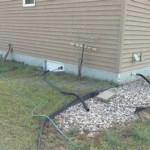What Does Black Mold Look Like On Basement Walls?
Basements, with their characteristic dampness and limited sunlight, often provide ideal conditions for mold growth. While many types of mold can flourish in these environments, black mold (Stachybotrys chartarum) is a particular concern due to its potential health implications. Accurate identification is crucial for effective remediation and prevention. This article will detail the appearance of black mold on basement walls, differentiating it from other types of mold and highlighting associated signs of moisture problems.
Appearance of Black Mold
Black mold doesn't always appear truly black. Its color can range from dark greenish-black to brownish-black, often exhibiting a slimy or sooty texture. Early growth may appear as small, dark spots, which can expand rapidly into larger patches or colonies. The texture can change depending on the surface and the stage of growth. On porous materials like drywall, it may appear embedded within the material, while on non-porous surfaces like concrete, it might be slightly raised. A slimy sheen is common, especially in actively growing colonies.
Differentiating Black Mold from Other Molds
Several other mold types can resemble black mold, making accurate identification challenging. Mildew, for example, often appears as a grayish-white or powdery substance, easily distinguished from the darker, more textured black mold. Other dark-colored molds, such as Cladosporium (often olive-green to black) and Alternaria (dark brown to black), can also be mistaken for Stachybotrys. Microscopic examination is the most definitive method for identifying mold species. Therefore, professional testing is highly recommended if black mold is suspected.
Signs of Moisture Problems
Identifying black mold often begins with recognizing signs of moisture intrusion. Water stains on walls, peeling paint, a musty odor, condensation on pipes or windows, and efflorescence (white crystalline deposits on concrete) are all indicators of potential moisture problems that can contribute to mold growth. These signs should be investigated promptly as moisture provides the necessary environment for mold to thrive. Addressing the underlying moisture source is crucial for preventing recurring mold infestations.
Locations of Black Mold Growth in Basements
While black mold can appear on virtually any surface in a damp basement, certain locations are more susceptible. Areas behind drywall, especially where leaks have occurred, are particularly vulnerable. Organic materials like wood framing and insulation also provide a food source for mold, making them prime locations for growth. Concrete walls themselves can support mold growth, particularly in areas with high humidity or water seepage. Corners, where airflow is often restricted, are also common sites for mold colonization.
Health Considerations Related to Black Mold
Exposure to any type of mold, including black mold, can cause health problems. While Stachybotrys chartarum produces mycotoxins, which are potentially harmful substances, the direct link between these toxins and specific health issues is a subject of ongoing research. However, individuals sensitive to mold can experience a range of symptoms, including respiratory issues (coughing, wheezing, shortness of breath), eye irritation, skin rashes, headaches, and fatigue. Individuals with pre-existing respiratory conditions like asthma or allergies may be particularly vulnerable to mold exposure.
Importance of Professional Mold Remediation
Attempting to remove black mold without proper safety precautions and techniques can exacerbate the problem by spreading spores throughout the basement and other areas of the home. Professional mold remediation specialists possess the expertise and equipment necessary to safely and effectively remove mold, address the underlying moisture issue, and prevent future growth. They follow established protocols to contain the affected area, remove contaminated materials, and thoroughly clean and disinfect the space. Professional testing after remediation confirms successful mold removal.
Preventing Mold Growth in Basements
Preventing mold growth relies on controlling moisture levels. Proper ventilation is key to reducing humidity. Installing a dehumidifier can also help maintain optimal humidity levels. Regularly inspecting for and repairing leaks promptly is crucial. Ensuring proper drainage around the foundation and grading the landscape to direct water away from the house are essential preventive measures. Keeping the basement clean and free of clutter improves airflow and reduces potential mold growth areas. Furthermore, using mold-resistant paints and building materials can help inhibit mold growth on susceptible surfaces.

Signs You Could Have Black Mold In Basement

Mold In The Basement Hgtv

How To Get Rid Of And Prevent Mold Growth On Concrete Environix

How To Remove Mold From Basement Walls In 2024

How To Get Rid Of Black Mold In Your Basement Acculevel

How To Get Rid Of And Prevent Mold Growth On Concrete Environix

How To Remove Mold Black In Basement

How To Get Rid Of And Prevent Mold Growth On Concrete Environix

Green White Yellow Black Mold On Basement Wall Cinder Blocks The Hound

How To Get Rid Of And Prevent Mold Growth On Concrete Environix
Related Posts







